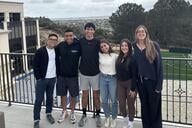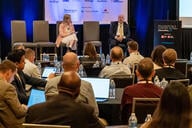You have /5 articles left.
Sign up for a free account or log in.

Istockphoto.com/cifotart
When it comes to ensuring educational technology is accessible to students with disabilities, the buck stops with institutions, not vendors.
This is a frustrating reality for many college accessibility staff, who feel vendors should shoulder more responsibility for the accessibility of their products. But it is institutions that are ultimately legally responsible for making sure that the learning materials they provide are accessible to all students.
The Los Angeles Community College District, for example, was successfully sued by two blind students earlier this year for its use of inaccessible digital courseware. The district was criticized for not testing the accessibility of these products during its procurement process.
Michael Cyr, a co-leader of the Educause IT Accessibility Community Group and director of architecture and service management at the University of Maine system, said around 50 percent of vendors he has worked with publicly share information about the accessibility of their products on their websites. Many of the rest provide this information on request, he said.
“We normally ask the manufacturer to provide a voluntary product accessibility template, but it’s considered a risk to rely on that,” said Cyr. “The VPAT is a voluntary document that is completed by staff with varying levels of expertise. Ideally, you would get a third party to do the testing and complete the VPAT for you -- that would be considered more reliable than what the vendor completes.”
Contracting a third party to verify manufacturers' accessibility claims is expensive and not something every institution can afford, said Cyr.
“Institutions really vary in their capacity to do this testing,” he said. “If you think about it, it’s also a tremendous waste for every institution to conduct its own testing and drives up the cost of education. Why are we all doing that?”
Sharing accessibility evaluations between institutions is not a new idea. There have been several efforts to create searchable libraries of VPATs, but none have been particularly successful, said Cyr. In 2017, for example, members of the Educause IT accessibility group floated the idea of creating a product testing group that would share product accessibility reviews.
Cyr said the project never really got off the ground. This was due in part to the expense and heavy workload involved. But there were also concerns about legal liability. Representatives at some institutions were hesitant to publicly share their accessibility evaluations in case they were later found to be inaccurate, he said.
Some vendors don’t want information about the accessibility of their products to be publicly available, said Cyr. He said that on a small number of occasions, he has been asked to sign nondisclosure agreements when requesting VPAT documents from manufacturers. He declined to share the names of which manufacturers made this request.
Companies don’t want to be ranked and compared on the accessibility of their products, but they do like to be recognized for the progress they have made, said Brad Turner, vice president of education and literacy for Benetech, a nonprofit that develops accessible technology.
Benetech launched a program in 2017 that evaluates whether publisher ebooks are accessible to people with reading barriers such as blindness, low vision, dyslexia or physical disability. The Global Certified Accessible program looks not just at the publishers’ products, but their production processes. Macmillan Learning was the first publisher to have its ebook production process certified earlier this year. Rachel Comerford, senior director of content standards and accessibility at Macmillan, said the company aims to clearly communicate the accessibility of its products.
"Accessibility is an important and complex topic," said Comerford in an email. "Every team for every product is looking at the compatibility of operating systems, browsers, assistive technologies, and most importantly, the users themselves who will have a unique set of knowledge and needs that will shape how accessible the experience is for them."
Institutions aren’t just duplicating accessibility evaluations for ed-tech products, said Turner. They are also needlessly modifying textbooks and course materials to make them accessible when other institutions have already done the hard work.
Benetech is participating in the creation of an online library called EMMA (Educational Materials Made Accessible) that will allow member institutions to find and use accessible educational materials created at other participating institutions. A pilot is being led by the University of Virginia, with funding from the Andrew W. Mellon Foundation. Benetech also manages an online library of accessible ebooks called Bookshare that is free to U.S. students with reading barriers.
“Twenty years ago, when we started, it was hard to convert a very simple trade book into an accessible format. Now that is fairly easy,” said Turner. “The challenge is STEAM content such as math equations, chemistry formulas, pictures of paintings.”
Though there are barriers to sharing accessibility evaluations, that doesn’t mean that all efforts have ceased. IMS Global Learning Consortium is working to create a platform for sharing reviews of the accessibility of educational apps, said Cary Brown, director of the group’s higher education program.
Brown said that IMS Global initially created a platform for sharing reviews on privacy standards of educational apps, which Brown describes as a kind of “Yelp for privacy,” but quickly realized there was demand for accessibility information.
“Talking to our members, we seem to be having some success with the privacy app vetting initiative. We’ve got over 3,000 vetted applications now. But members started asking if there is any way we could do the same thing for accessibility, to alleviate some of that vetting and assessment process,” he said.
"It's a duplication of effort on the part of institutions and school districts. It’s also a duplication of effort by suppliers, as they are responding to the same questions and concerns over and over. We may never alleviate all of the burden, but perhaps we could alleviate some of it.”
IMS Global has just begun the process of drawing up a rubric to assess app accessibility. Exactly how much the rubric will rely on vendor claims versus independent testing is yet to be decided, said Brown.
“It’s very early days at this point,” he said. “The primary challenge is going to be identifying what the criteria are that we can reasonably assess against. Then scaling up the input from institutions and districts so that we have a critical mass of results.”
“One of the reasons an initiative like this emerges is because consumers feel there is a gap. If this can lead to a stronger dynamic between suppliers and consumers, that would be a worthy goal.”




